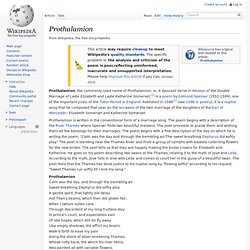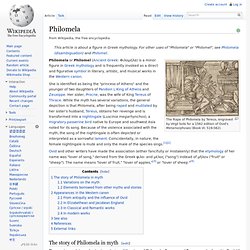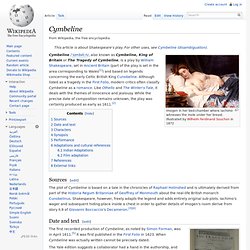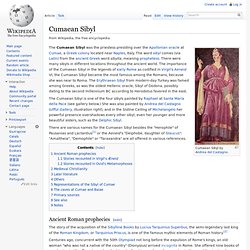

3. Sweeney Erect. T.S. Eliot. 1920. Poems. The Pervigilium Veneris. This remarkable poem which may date from somewhere in the 2/3 c.

A.D., is of a genre otherwise totally unknown to us. First, it is clearly accentual poetry, that is it does not depend on the long and short syllabification of Classics Latin poetry, but on a regular stress pattern. Second, its thematic material is light, lovely, natural and thoroughly un-Classical. The poem apparently describes a three day holiday in the cult of Venus, located somewhere in Sicily, involving the whole town in religious festivities joined with a deep sense of nature and Venus as the "procreatrix", the life-giving force behind the natural world. Lucretius has had the same vision, but in entirely different terms, in the prefaces to each of his books in the De Rerum Nature. There is a brilliant evocation and translation of this poem in Walter Pater's famous l9th c. I reproduce the text here since it is much lauded but not often made available.
CrAs amEt qui nUnquam amAvit quIque amAvit crAs amEt. 630. O Swallow, Swallow. Alfred, Lord Tennyson. 1909-14. English Poetry III: From Tennyson to Whitman. The Harvard Classics. Philebus. Users.utu.fi/hansalmi/gotterdammerung.html. Richard Wagner's Operas Götterdämmerung (1848-74) Vorspiel und drei Aufzüge Name before 1863: Siegfrieds TodLibretto: Richard WagnerPremiere: August 17, 1876 Festspielhaus Bayreuth Characters: Siegfried (Tenor) Brünnhilde (Sopran) Gunther (Bariton) Hagen (Bass) Alberich (hoher Bass) Gutrune (Sopran) Waltraute (Mezzosopran) Drei Nornen, drei Rheintöchter (Sopran und Alt)

The Parliament of Bees - T.S. Eliot's The Waste Land Wiki. 357. To His Coy Mistress. Andrew Marvell. The Oxford Book of English Verse. Prothalamion. Prothalamion, the commonly used name of Prothalamion; or, A Spousall Verse in Honour of the Double Marriage of Ladie Elizabeth and Ladie Katherine Somerset,[1] is a poem by Edmund Spenser (1552-1599), one of the important poets of the Tudor Period in England.

Published in 1596[1] (see 1596 in poetry), it is a nuptial song that he composed that year on the occasion of the twin marriage of the daughters of the Earl of Worcester; Elizabeth Somerset and Katherine Somerset. There, in a meadow, by the river's side, A flock of nymphs I chanced to espy, All lovely daughters of the flood thereby, With goodly greenish locks, all loose untied, As each had been a bride; And each one had a little wicker basket, Made of fine twigs, entrailed curiously, In which they gathered flowers to fill their flasket, And with fine fingers cropt full feateously The tender stalks on high.
The poem is often grouped with Spenser's poem about his own marriage, the Epithalamion. Notes[edit] External links[edit] SCENE II. The island. Before PROSPERO'S cell. Philomela. The Rape of Philomela by Tereus, engraved by Virgil Solis for a 1562 edition of Ovid's Metamorphoses (Book VI, 519-562).

Philomela or Philomel (Ancient Greek: Φιλομήλα) is a minor figure in Greek mythology and is frequently invoked as a direct and figurative symbol in literary, artistic, and musical works in the Western canon. She is identified as being the "princess of Athens" and the younger of two daughters of Pandion I, King of Athens and Zeuxippe. Her sister, Procne, was the wife of King Tereus of Thrace. While the myth has several variations, the general depiction is that Philomela, after being raped and mutilated by her sister's husband, Tereus, obtains her revenge and is transformed into a nightingale (Luscinia megarhynchos), a migratory passerine bird native to Europe and southwest Asia noted for its song. Metamorphoses by Ovid. Cymbeline. Imogen in her bed-chamber where Iachimo witnesses the mole under her breast.

Illustrated by Wilhelm Ferdinand Souchon in 1872 Cymbeline /ˈsɪmbɨliːn/, also known as Cymbeline, King of Britain or The Tragedy of Cymbeline, is a play by William Shakespeare, set in Ancient Britain (part of the play is set in the area corresponding to Wales[1]) and based on legends concerning the early Celtic British King Cunobeline. Although listed as a tragedy in the First Folio, modern critics often classify Cymbeline as a romance.
Like Othello and The Winter's Tale, it deals with the themes of innocence and jealousy. While the precise date of composition remains unknown, the play was certainly produced as early as 1611.[2] Sources[edit] Walter Pater - Mona Lisa. Cumaean Sibyl. The Cumaean Sibyl is one of the four sibyls painted by Raphael at Santa Maria della Pace (see gallery below.)

She was also painted by Andrea del Castagno (Uffizi Gallery, illustration right), and in the Sistine Ceiling of Michelangelo her powerful presence overshadows every other sibyl, even her younger and more beautiful sisters, such as the Delphic Sibyl. There are various names for the Cumaean Sibyl besides the "Herophile" of Pausanias and Lactantius[1] or the Aeneid's "Deiphobe, daughter of Glaucus": "Amaltheia", "Demophile" or "Taraxandra" are all offered in various references. Ancient Roman prophecies[edit] Tristan und Isolde.